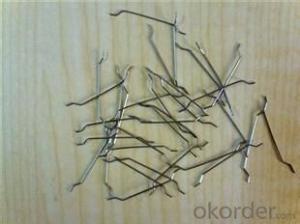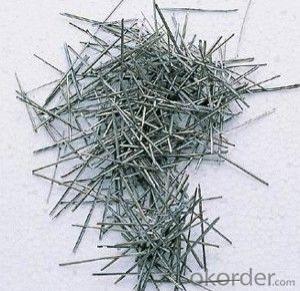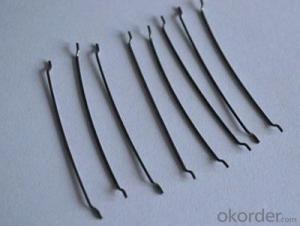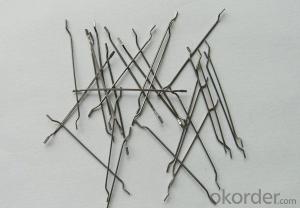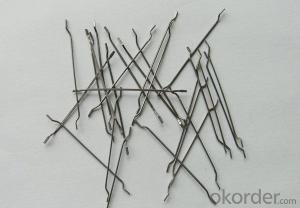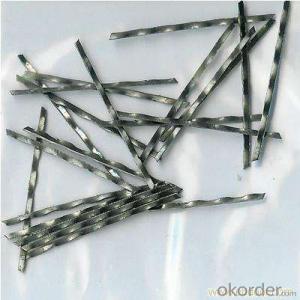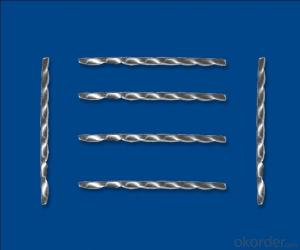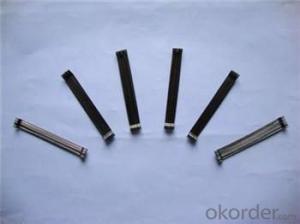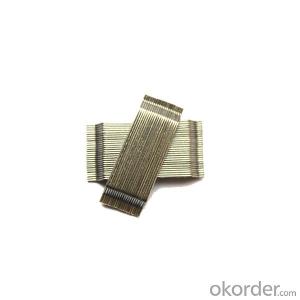Concrete steel fiber 0.9/50 from CNBM China
- Loading Port:
- Tianjin
- Payment Terms:
- TT OR LC
- Min Order Qty:
- 1 m.t.
- Supply Capability:
- 5000 m.t./month
OKorder Service Pledge
Quality Product, Order Online Tracking, Timely Delivery
OKorder Financial Service
Credit Rating, Credit Services, Credit Purchasing
You Might Also Like
Quick Details
Place of Origin: Tianjin, China (Mainland)
Model Number: 0.9
Material: Steel
Production Process: Cold drawn
Lengh: 50
Type: 1
Compressive Strength: >1200MPa
Aspect ratio: 56
Standard: ASTM A820M-11
Section Shape: Circular
Application: Concrete Reinforcement
Packaging & Delivery
| Packaging Details: | 20 kg/Bag,50 bags/Pallet or 1,000kg/ Bulk Bag |
|---|---|
| Delivery Detail: | 1 Month |
Product Description
| Diameter | 0.90 | mm | 0.04 | in |
| Length | 50.00 | mm | 1.96 | in |
| Aspect Ratio | 56 | |||
| Tensile strength | 1200 MPa | |||
| Type | Cold drawn Steel Fiber | |||
| End | Hooked-end Steel Fiber | |||
| Glued/Loose | Glued Steel Fiber | |||
| Bending Angle | 45°(min.30°) | |||
| Usage & Performance | Floor:Trafficked areas and Industrial floors | |||
| Shotcrete :Slope stabilization and Final lining | ||||
| Precast concrete:Pipe and Railway sleepers | ||||
| Packing | Standard Export Pallet Packing | Bag Packing | 20 kg/Bag,50 bags/Pallet | |
| Bulk Packing | 1,000kg/ Bulk Bag | |||
| Loading Quantity | 20’GP | 20-25 Tonne/Tonnes | ||
| 40’GP | 25-27 Tonne/Tonnes | |||
| 40’HQ | 25-27 Tonne/Tonnes | |||
| MOQ | 1 kg for trial order | |||
| Supply Ability | 10,000 Tonne/Tonnes per Year | |||
| Payment Terms | T/T or L/C at sight | |||
| Delivery Time | Within 15 days after receiving deposit or original L/C at sight | |||
| Certification | ISO9001:2000, CE, | |||
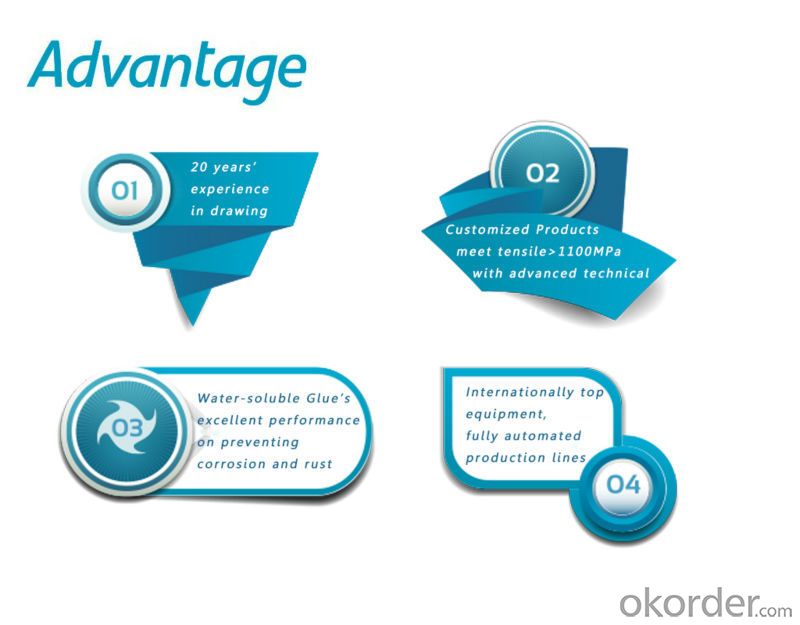
| Product | Diameter | Length mm/in | Aspect Ratio | Type | Packing |
| G-6030 | 0.5 mm (0.0197 in) | 30 mm (1.1811 in) | 60 | Glued | 20 kg/Bag, or 1,000kg/ Bulk Bag |
| G-6535 | 0.55 mm (0.0217 in) | 35 mm (1.3780 in) | 65 | Glued | 20 kg/Bag, or 1,000kg/ Bulk Bag |
| G-6035 | 0.6 mm (0.0236 in) | 35 mm (1.3780 in) | 60 | Glued | 20 kg/Bag, or 1,000kg/ Bulk Bag |
| G-8060 | 0.75 mm (0.0295 in) | 60 mm (2.3622 in) | 80 | Glued | 20 kg/Bag, 50 bags/Pallet |
| G-6060 | 0.9 mm (0.0354 in) | 60 mm (2.3622 in) | 60 | Glued | 20 kg/Bag, 50 bags/Pallet |
| G-6030 | 0.5 mm (0.0197 in) | 30 mm (1.1811 in) | 60 | Loose | 20 kg/Bag, or 1,000kg/ Bulk Bag |
| G-6535 | 0.55 mm (0.0217 in) | 35 mm (1.3780 in) | 65 | Loose | 20 kg/Bag, or 1,000kg/ Bulk Bag |
| G-6035 | 0.6 mm (0.0236 in) | 35 mm (1.3780 in) | 60 | Loose | 20 kg/Bag, or 1,000kg/ Bulk Bag |
| G-8060 | 0.75 mm (0.0295 in) | 60 mm (2.3622 in) | 80 | Loose | 20 kg/Bag, 50 bags/Pallet |
| G-6060 | 0.9 mm (0.0354 in) | 60 mm (2.3622 in) | 60 | Loose | 20 kg/Bag, 50 bags/Pallet |
- Q:Can melt extract stainless steel fiber be used in marine construction?
- Yes, melt extract stainless steel fiber can be used in marine construction. Stainless steel is highly resistant to corrosion, which makes it a suitable material for marine environments where exposure to saltwater, moisture, and other corrosive elements is high. The melt extract stainless steel fiber can be incorporated into concrete or other building materials used in marine construction to enhance their strength, durability, and resistance to corrosion. This can help increase the lifespan of structures in marine environments and reduce the need for frequent maintenance and repair. Additionally, the use of stainless steel fiber in marine construction can also improve the overall structural integrity and performance of the built environment in these challenging conditions.
- Q:Can melt extract stainless steel fiber be used in bridge deck overlays for asphalt mixtures?
- Bridge deck overlays for asphalt mixtures can indeed utilize melt extract stainless steel fiber. By incorporating these fibers, the overall performance and durability of the asphalt mixtures are enhanced. The introduction of stainless steel fibers aids in the improvement of tensile strength, crack resistance, and fatigue resistance for the asphalt overlay. This is especially advantageous for bridge deck overlays due to the heavy traffic loads, temperature fluctuations, and exposure to various environmental conditions they encounter. Moreover, the stainless steel fibers provide reinforcement, preventing the formation and spread of cracks, ultimately extending the service life of the bridge deck. Furthermore, the corrosion-resistant nature of stainless steel renders it a fitting choice for bridge deck overlays, where exposure to moisture and deicing salts is commonplace. In summary, the incorporation of melt extract stainless steel fibers in bridge deck overlays for asphalt mixtures presents a feasible solution to enhance the performance and durability of the overlay system.
- Q:Does melt extract stainless steel fiber enhance the crack resistance of concrete?
- Concrete's crack resistance is enhanced by melt extract stainless steel fiber. To improve the tensile strength and prevent crack formation and propagation, stainless steel fibers are added to concrete mixes. Acting as reinforcement within the concrete matrix, these fibers provide additional strength and durability. When evenly dispersed throughout the concrete, these fibers form a three-dimensional network that helps distribute stress and load more uniformly. This reduces the likelihood of cracks forming and spreading, ultimately enhancing the concrete's overall crack resistance. Melt extract stainless steel fibers possess a high melting point and excellent corrosion resistance, making them highly effective in harsh environments or when exposed to chemicals. These fibers can endure high temperatures and prevent spalling or cracking of the concrete under extreme conditions. Moreover, the inclusion of stainless steel fibers improves the impact resistance and flexural strength of the concrete, rendering it more resilient to cracking caused by external forces or dynamic loads. In summary, melt extract stainless steel fiber positively contributes to the crack resistance of concrete by reinforcing the material and enhancing its tensile strength. Consequently, this leads to a more enduring and long-lasting concrete structure.
- Q:How does melt extract stainless steel fiber affect the fire resistance of concrete?
- Melt extract stainless steel fiber has a significant positive impact on the fire resistance of concrete. When added to the concrete mix, these fibers enhance the material's ability to withstand high temperatures and prevent fire from spreading rapidly. The key reason behind this improvement is the unique properties of stainless steel fibers. These fibers are made of a high-grade stainless steel alloy that can withstand extremely high temperatures without losing its structural integrity. Thus, when exposed to fire, the stainless steel fibers in the concrete act as a reinforcement, preventing the concrete from cracking or spalling under thermal stress. Additionally, the presence of stainless steel fibers helps to increase the concrete's thermal conductivity. This means that the heat generated during a fire is more efficiently dissipated throughout the concrete, reducing the risk of localized hotspots that could compromise the structural stability of the material. Furthermore, melt extract stainless steel fibers also enhance the overall durability and strength of the concrete. They form a three-dimensional matrix within the concrete, improving its resistance to cracking and deformation caused by heat. In summary, the addition of melt extract stainless steel fiber to concrete significantly enhances its fire resistance. These fibers provide reinforcement, improve thermal conductivity, and increase the overall durability of the concrete. Therefore, incorporating stainless steel fibers into concrete mixtures is a reliable and effective method to improve the fire resistance of concrete structures.
- Q:What is the effect of melt extract stainless steel fiber on the thermal conductivity of concrete?
- The thermal conductivity of concrete can be greatly improved by incorporating melt extract stainless steel fiber. Stainless steel fibers possess excellent thermal conductivity properties, enabling them to effectively transfer heat throughout the concrete. When these fibers are added to the concrete mixture, they create a three-dimensional network that aids in the efficient conduction and distribution of heat. This enhanced thermal conductivity has multiple positive impacts on the performance of the concrete. To begin with, the heightened thermal conductivity can enhance the overall thermal efficiency of structures constructed with this particular type of concrete. It facilitates better heat transfer, leading to more efficient temperature regulation and reducing the need for additional insulation or heating and cooling systems. Furthermore, the improved thermal conductivity can also enhance the durability of the concrete. By evenly distributing heat and minimizing temperature variations, the risk of thermal cracking and damage due to expansion and contraction is diminished. This is particularly advantageous in environments with substantial temperature fluctuations. Moreover, the greater thermal conductivity provided by melt extract stainless steel fiber can also be beneficial in applications like radiant floor heating systems. The fibers effectively transfer heat from the heating elements to the surface, resulting in more efficient and effective heating. In conclusion, the incorporation of melt extract stainless steel fiber in concrete significantly improves its thermal conductivity. This improvement leads to increased thermal efficiency, enhanced durability, and improved performance in various applications where heat transfer is crucial.
- Q:What is the effect of melt extract stainless steel fiber on the deflection of concrete slabs?
- The effect of melt extract stainless steel fiber on the deflection of concrete slabs is generally positive. The incorporation of stainless steel fibers in concrete slabs helps to enhance their flexural and structural properties, resulting in reduced deflection. Stainless steel fibers act as reinforcement within the concrete matrix, improving its tensile strength and crack resistance. When subjected to external loads or forces, the fibers distribute the stress more evenly throughout the slab, reducing the likelihood of excessive deflection or failure. This is particularly beneficial in applications where the concrete slabs are subjected to heavy loads or dynamic forces, such as in industrial or high-traffic areas. Additionally, the use of melt extract stainless steel fibers in concrete slabs can also enhance their overall durability and lifespan. The fibers provide an additional layer of protection against cracking and deterioration, resulting in a longer service life for the slabs. It is worth noting that the effect of melt extract stainless steel fiber on deflection also depends on other factors such as the fiber content, aspect ratio, and distribution within the concrete mix. Proper design and dosage of the fibers should be considered to achieve the desired effect on deflection control. In conclusion, incorporating melt extract stainless steel fibers in concrete slabs has a positive effect on their deflection. The fibers improve the flexural and structural properties of the concrete, reducing deflection and enhancing overall durability. Proper design and dosage of the fibers are crucial to ensure optimal results.
- Q:How does the addition of melt extract stainless steel fiber impact the flowability of concrete?
- The addition of melt extract stainless steel fiber can significantly impact the flowability of concrete. Stainless steel fibers are typically added to concrete to enhance its mechanical properties, such as increasing its tensile and flexural strength, improving its durability, and reducing cracking. However, the addition of stainless steel fibers can also affect the flowability of the concrete mixture. The presence of fibers in the concrete can increase its viscosity, making it more resistant to flow. This can be particularly noticeable in high fiber volume concrete mixtures. The flowability of concrete is commonly measured using the slump test, which measures the consistency and workability of the concrete. When stainless steel fibers are added, the slump of the concrete can decrease, indicating a reduction in flowability. Nevertheless, the impact of stainless steel fibers on flowability can be controlled and managed through proper mix design and dosage. By adjusting the fiber content, the size and shape of the fibers, and the water-to-cement ratio, the flowability of the concrete can be optimized to meet the specific requirements of the project. In conclusion, the addition of melt extract stainless steel fibers can have a noticeable impact on the flowability of concrete. However, with proper mix design and dosage, the flowability can be controlled and adjusted to achieve the desired performance characteristics of the concrete.
- Q:Is melt extract stainless steel fiber suitable for use in seismic regions?
- Yes, melt extract stainless steel fiber is suitable for use in seismic regions. Seismic regions are prone to earthquakes and require materials that can withstand the forces and movements generated during seismic events. Melt extract stainless steel fiber has excellent tensile strength and ductility, making it highly resistant to cracking and breaking under intense shaking and ground movement. It also provides enhanced flexural and shear strength to concrete, which is crucial for the structural integrity of buildings and infrastructure in seismic regions. Additionally, stainless steel fibers are corrosion-resistant, ensuring long-term durability and performance in these areas. Therefore, melt extract stainless steel fiber is a reliable and suitable choice for reinforcing concrete structures in seismic regions, providing added safety and stability during seismic events.
- Q:What is the effect of melt extract stainless steel fiber on the fatigue resistance of concrete?
- The melt extract stainless steel fiber has a positive effect on the fatigue resistance of concrete. It helps to improve the overall durability and strength of the concrete, making it more resistant to fatigue failure under cyclic loading conditions. The fiber reinforcement enhances the ability of the concrete to withstand repeated stress and strain, reducing the risk of cracking and extending the service life of the structure.
- Q:Can melt extract stainless steel fiber be used in structural repair applications?
- Yes, melt extract stainless steel fiber can be used in structural repair applications. This type of fiber is made by melting stainless steel and then rapidly extracting it into filaments, resulting in a strong and durable material. Due to its high strength and corrosion resistance, melt extract stainless steel fiber is commonly used in concrete repair and reinforcement applications. It can be added to the concrete mix to enhance its structural integrity, increase durability, and prevent cracking. This fiber can also be used to repair damaged structures by adding it to the repair mortar or concrete to strengthen the repaired area. Overall, melt extract stainless steel fiber is a suitable choice for structural repair applications due to its excellent mechanical properties and ability to enhance the performance and longevity of repaired structures.
1. Manufacturer Overview |
|
|---|---|
| Location | |
| Year Established | |
| Annual Output Value | |
| Main Markets | |
| Company Certifications | |
2. Manufacturer Certificates |
|
|---|---|
| a) Certification Name | |
| Range | |
| Reference | |
| Validity Period | |
3. Manufacturer Capability |
|
|---|---|
| a)Trade Capacity | |
| Nearest Port | |
| Export Percentage | |
| No.of Employees in Trade Department | |
| Language Spoken: | |
| b)Factory Information | |
| Factory Size: | |
| No. of Production Lines | |
| Contract Manufacturing | |
| Product Price Range | |
Send your message to us
Concrete steel fiber 0.9/50 from CNBM China
- Loading Port:
- Tianjin
- Payment Terms:
- TT OR LC
- Min Order Qty:
- 1 m.t.
- Supply Capability:
- 5000 m.t./month
OKorder Service Pledge
Quality Product, Order Online Tracking, Timely Delivery
OKorder Financial Service
Credit Rating, Credit Services, Credit Purchasing
Similar products
New products
Hot products
Hot Searches
Related keywords
